

M.curiosity. Watch: Why grandmothers are so important to our species' survival. Humans are living longer all the time thanks to advances in hygiene and medicine.

But even before the industrial revolution, Homo sapiens were one of the longest living species on the planet. Why? As the latest episode of How Did We Get Here by the University of New South Wales (UNSW) explains, a lot of that longevity is thanks to our grandmothers. Even though it's normal for large-bodied mammals to live longer than their smaller counterparts, humans are one of the rare mammals whose females live for years after menopause. Given traditional evolutionary theory, having individuals around sucking up resources when they're no longer able to contribute to the gene pool doesn't make a whole lot of sense.
As evolutionary biologist Darren Curnoe explains in the video, they might have given humans the support they needed to become such a successful species. So what's changed now that we're no longer as close with our grandparents as we used to be? First Neanderthal etching is a #stoneagehashtag - life - 01 September 2014. Video: First Neanderthal etching is a #stoneagehashtag Idle doodle, a game of Stone Age tic-tac-toe, or the first evidence of Neanderthal art?

No one can say. But two things seem reasonably clear: these scratches in the hard stone floor of a cave in Gibraltar are the work of a Neanderthal, and they were made quite purposefully more than 40,000 years ago. Some say they are abstract symbols of some description, bolstering the notion that Neanderthals were capable of subtle symbolic thought. Others remain to be convinced. Neanderthals could speak like modern humans, study suggests. 20 December 2013Last updated at 11:06 ET By Melissa Hogenboom Science reporter, BBC News Neanderthals may have had complex language An analysis of a Neanderthal's fossilised hyoid bone - a horseshoe-shaped structure in the neck - suggests the species had the ability to speak.
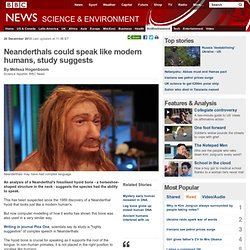
This has been suspected since the 1989 discovery of a Neanderthal hyoid that looks just like a modern human's. Discovery Of Oldest Human Poop Exposes The Original Paleo Diet. "but it's fair to say their digestive systems, after tens of thousands of years of evolution, were very well adapted to these particular foods.

" Wouldn't it only be fair to say that if 1) we had clear evidence that they'd been eating those particular foods for tens of thousands of years, and 2) we had some other group of neanderthals to compare them to, and 3) we had enough data on both groups to make a statement about how their respective diets affected their general well-being? I mean, maybe those Neanderthals all died out precisely because their digestive systems WEREN'T optimized for what they were eating.
Further evidence that Asians colonized the Americas long before Europeans did. Contrary to the claims of a recent study, the multiregional model, which states that modern humans evolved from several different groups of hominids (including Neanderthals) that interbred at some point to produce modern humans, fails to explain the genetics seen in modern humans, Neanderthals, and early modern humans.

The biblical model (stating that humans arose from one lineage from a single geographic location) still fits all the data better than the multiregional model. Previous anatomical studies have cast doubt on the likelihood of Neanderthals being the ancestors of modern humans. These studies showed differences in Neanderthal's hands, the brain case, and numerous other features of the Neanderthal skull. Americas' Natives Have European Roots. The 24,000-year-old remains of a young boy from the Siberian village of Mal’ta have added a new root to the family tree of indigenous Americans.
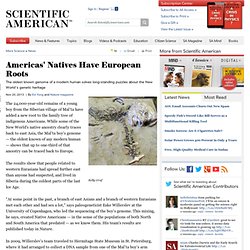
While some of the New World's native ancestry clearly traces back to east Asia, the Mal’ta boy’s genome — the oldest known of any modern human — shows that up to one-third of that ancestry can be traced back to Europe. The results show that people related to western Eurasians had spread further east than anyone had suspected, and lived in Siberia during the coldest parts of the last Ice Age. Fossils confirm three early humans roamed Africa - life - 08 August 2012. Few treasure hunts last 40 years.
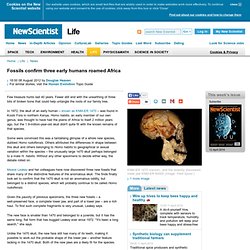
Time flows uphill for remote Papua New Guinea tribe - science-in-society - 31 May 2012. "HERE and now", "Back in the 1950s", "Going forward"...
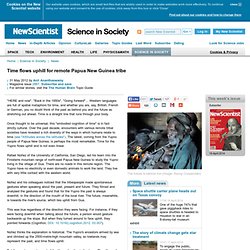
Western languages are full of spatial metaphors for time, and whether you are, say, British, French or German, you no doubt think of the past as behind you and the future as stretching out ahead. Time is a straight line that runs through your body. Why Do Babies Have Soft Spots? Humans Really Are Still Evolving, Study Finds. Natural forces of evolution still continue to shape humanity despite the power we have to profoundly alter the world around us, researchers say.
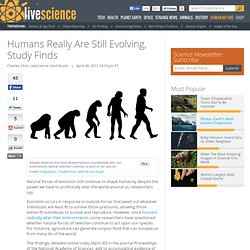
Evolution occurs in response to outside forces that weed out whatever individuals are least fit to survive those pressures, allowing those better-fit individuals to survive and reproduce. However, since humans radically alter their environments, some researchers have questioned whether natural forces of selection continue to act upon our species. For instance, agriculture can generate surplus food that can insulate us from many ills of the world. The findings, detailed online today (April 30) in the journal Proceedings of the National Academy of Sciences, add to accumulating evidence of our continued evolution. For instance, past research has suggested the human brain has been shrinking over the past 5,000 years. As with most animal species, men and women are not equal when it comes to natural selection, the researchers found.
Chinese human fossils unlike any known species - life - 14 March 2012. And so it begins.
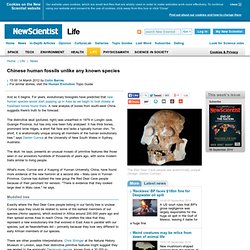
For years, evolutionary biologists have predicted that new human species would start popping up in Asia as we begin to look closely at fossilised bones found there. A new analysis of bones from south-west China suggests there's truth to the forecast. The distinctive skull (pictured, right) was unearthed in 1979 in Longlin cave, Guangxi Province, but has only now been fully analysed. It has thick bones, prominent brow ridges, a short flat face and lacks a typically human chin. Could the first humans to reach the Americas have come from Europe? Neanderthals were ancient mariners - life - 29 February 2012. IT LOOKS like Neanderthals may have beaten modern humans to the seas. Neandertal population structure. The extinction of Neanderthals had nothing to do with us. First Painters May Have Been Neanderthal, Not Human.
Detail from the Panel of Hands in El Castillo Cave, Spain. The hand stencils are dated to 37,300 years old. (Pedro Saura) [High-resolution] Image: Claviform symbol dated to 35,600 years old in the Altamira Cave, Sapin. The claviform is older than the bison in the background. Humans Have Been Making Art for a Lot Longer Than We Thought. One of the prints in El Castillo Cave’s Panel of Hands was created more than 37,300 years ago.
A new study has revealed that Spain’s El Castillo Cave contains the oldest known cave paintings in Europe, with a handprint dating back 37,300 years and a red circle that was daubed onto the wall at least 40,600 years ago. Instead of testing the paint’s age, a team of British and Spanish researchers measured the age of the stone that had formed around the drawings. In a cave, mineral-rich water drips over the walls, eventually depositing stalactites, stalagmites, and the sheet-like formations called flowstone. Some prehistoric artists had painted over flowstone made out of the mineral calcite, and then water flowed over the paint and deposited even more calcite, leaving the drawings sandwiched between mineral layers.
Another set of paintings in El Castillo Cave, called Corredor de los Puntos. Modern culture began in South Africa 44,000 years ago - life - 30 July 2012. Call it the end of the late late show. The Later Stone Age technology was thought to have made its first appearance in South Africa much later than it did in Europe. A new analysis of South African finds suggests modern culture emerged in both areas at the same time. In Europe, the Upper Palaeolithic – another term for the Later Stone Age – is commonly dated to around 45,000 years ago. In South Africa the archaeological evidence suggests the Later Stone Age did not begin until much later – around 22,000 years ago. Did Africa's Apes Come From Europe? Some fossil evidence indicates the common ancestor of gorillas (shown), chimpanzees and humans came from Europe. Image courtesy of Flickr user Jenny Varley Europe is not where most people would search for the common ancestor of chimpanzees, gorillas and humans.
Our ancestors may have originated in Asia, not Africa. Copping a Latitude: Genetics Supports Idea Cultural Interaction Was More East to West Than North to South. East often meets West and vice versa, but did North frequently meet South when it comes to the history of people and technological innovations migrating across the continents? Stone Tools Shed Light on Early Human Migrations. Cold Cases: Scientists use a variety of tools to help them identify human remains [Video and Slide Show] Distinguishing between male and female human remains can be tricky, especially in cases where only partial skeletons are found. Ann Ross, a forensic anthropologist at North Carolina State University in Raleigh, and her colleagues have developed a new computer program called 3D ID that helps researchers make such distinctions based on skulls.
Check out the video below, and as you watch the female and male skulls rotate, look for these features: Meet Your Newest Ancestor. The Newest Member of the Human Family Tree. South African fossils halfway between ape and human - life - 08 September 2011. Two fossil skeletons of early humans appear to mark a halfway stage between primitive "ape-men" and our direct ancestors. A year of detailed study has revealed that the skeletons are a hodgepodge of anatomical features: some bones look almost human while others are chimpanzee-like.
The two fossils, an adult female and a juvenile male, were discovered in the Malapa cave system near Johannesburg, South Africa, in 2008. Both about 1.2 metres tall, they are unusually complete and well-preserved and date from 1,977,000 years ago. Dear Professor, I think my husband may be a Neanderthal. Neanderthals more advanced than thought. DENVER – For decades scientists believed Neanderthals developed `modern’ tools and ornaments solely through contact with Homo sapiens, but new research from the University of Colorado Denver now shows these sturdy ancients could adapt, innovate and evolve technology on their own. Find Your Inner Neanderthal. Modern humans raced across Europe. Our ancestors speak out after 3 million years - life - 23 November 2011. By Charles Harvey. Fossil Finds Complicate Search for Human Ancestor.
How Africa Became the Cradle of Humankind. Cooking May Have Driven Human Evolution. Meet the Contenders for Earliest Modern Human. Ancient Pots Show How Humans Adopted Farming. Modern Humans Once Mated with Other Species. DNA Evidence: Neanderthals Had Sex with Humans. Finger Bone Points to New Branch of Humanity. Sex with Neanderthals Gave Humans Immunity Boost. Neanderthal-Human Sex Rarely Produced Kids, Study Suggests.
Asian Ancestors Had Sex with Mysterious Human Cousins. Man Entered the Kitchen 1.9 Million Years Ago. Humans Had Sex Regularly With Mysterious Extinct Relatives in Africa. Australopithecus Sediba & Human Evolution. Neanderthal Mysteries & Neanderthal Hunters. Now-Extinct Relative Had Sex with Humans Far and Wide. Natural Selection, Human Evolution & Reproduction. Amazing Caves: Pictures of the Earth's Innards. Archaeologists unearth 5,000-year-old 'third-gender' caveman. 1 in 200 men direct descendants of Genghis Khan. What do ancient penis decorations say about us? 33,000 year old dog skull discovered in Siberian cave.
Ancient humans just couldn't stop having sex with Neanderthals. How Agriculture Made Our Mouths Too Small for our Teeth. Why the shape of the Americas was bad for human settlement. Ancient humans understood medicine and insecticides over 77,000 years ago.